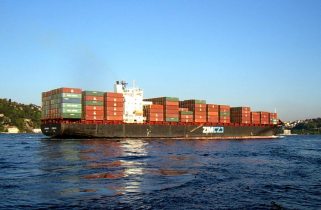Carriers Say Merry Christmas to Shippers with Freight Rate Increases
by Jared Vineyard
Carriers know exactly what shippers want for the holidays: increased shipping rates. Merry Christmas!
 Actually, most holiday international shipping has already taken place to make sure products from China and other parts of Asia are already on the shelves for people to buy for Christmas. Still, it feels like something of an anti-Christmas present to announce increased shipping prices right as Christmas is hitting.
Actually, most holiday international shipping has already taken place to make sure products from China and other parts of Asia are already on the shelves for people to buy for Christmas. Still, it feels like something of an anti-Christmas present to announce increased shipping prices right as Christmas is hitting.
To bring shipping rates, especially in the spot market, up to manageable levels, carriers with shipping lines from Asia to the U.S. are implementing a two-fold general rate increase (GRI) plan.
GRIs have become a common thing in the international shipping industry. In 2012, we started seeing a great deal of GRIs from carriers as they tried to increase freight rates to profitable levels after seeing losses in the billions the previous year largely due to rates pushed down by overcapacity.
Even though GRIs have often seemed to be coordinated between the carriers, there have been struggles in making GRIs stick. Maintaining healthy freight rate levels to maintain profitability has been difficult for carriers. It will have to be seen how well the latest GRIs will do.
These new GRIs are from members of the Transpacific Stabilization Agreement (TSA). In their own words, “TSA is a research and discussion forum container shipping lines offering freight transportation, logistics and supply chain services between Asia and the U.S.”
We’ve talked a bit about TSA in previous blogs. Basically, they research the shipping line market between Asia and the U.S. and make recommendations to the carriers who are members as to how and when they should raise their rates to bring profitability to the international shipping industry for carriers. It seems the recommendations are almost always in the form of more GRIs.
Their latest recommendation is two sets of GRIs, one implemented last week and another to be implemented here in January.
The Journal of Commerce (JOC) reported, “Freight Index rose in the week ending Dec. 20, in response to the first round of the 2-stage rate increase proposed by the Transpacific Stabilization Agreement. Carriers such as Hapag-Lloyd, OOCL, US Lines and COSCO announced GRIs of $200 per 40-foot container, effective Dec. 20.”
While GRIs of $200 per 40-foot container were announced for last week, that doesn’t mean $200 per 40-foot container is the exact increase that took place in practice.
JOC continued,
The spot rate from Shanghai to the U.S. West Coast climbed 6.7 percent, or $114, from the week ending Dec. 13… This was a 57.0 percent achievement of the proposed GRI. The spot rate in the week ending Dec. 20 is 18.7 percent below the level in the same week last year and 18.3 percent, or $407, less than at the beginning of 2013.
So while last week’s GRI increased freight rates from Shanghai to the U.S. West Coast from what it was the previous week, it has not caused freight rates to reach the levels they were at last year at this time.
In regards to the spot rates from Asia to the U.S. East Coast, JOC reports,
The spot rate to the U.S. East Coast rose 5.2 percent, or $155 per FEU… achieving 77.5 percent of the proposed GRI. Despite the increase, the current rate remains down 8.0 percent year-over-year, and down 7.2 percent, or $241, from Jan. 1.
Again, we are looking at increased rates, but not to the levels they were last year or even as high as what they were at the beginning of this year.
As next year begins, we’ll see phase 2 of the TSA freight rate GRI plan.
The next GRI planned is larger than the first one. Scheduled to go into effect on January 15, 2014 is a GRI of $300 per 40-foot container for the Asia-to-U.S. trade lane.
Of course, considering that the GRI for Asia to the U.S. West Coast only ended up being 57% of the proposed rate increase and the rate increase from Asia to the U.S. East Coast was only 77.5% of the proposed GRI, we could see an increase in freight rates that are significantly less than the $300 TSA proposes.
Then will be the question of whether or not carriers are able to maintain the freight rate increases as they struggle with such possible factors as overcapacity and competing freight rates from other shipping lines.
As always, Universal Cargo Management is here to get the best rates we can for you while maintaining excellent service for your international shipping, whether it is transpacific shipping from China to the U.S. or importing from or exporting to anywhere else in the world you do business.
Sources:
![]()
Source: China

